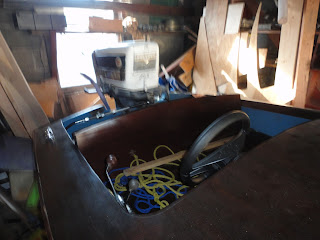PT's Boats
This blog is dedicated to boat and boat building enthusiasts everywhere. You too can build your own boat.
Sunday, January 29, 2017
Sunday, May 12, 2013
Stiletto Update
It's been nearly two years of intermittent work and long delays in building the Stiletto; but it's almost ready to launch. All that's left to do is install the carpet and fire up the motor to test it before launching. People who see it keep raving about it. So far no one has come up with the $13000 to take it home. It looks like I'll be touring the regattas and shows with it this summer.
Tuesday, April 16, 2013
Nestled in Morris County in north central NJ is beautiful Lake Hopatcong. It is the largest lake in NJ and has been a favorite vacation and recreational area for more than 100 years. The memories I have of spending my summers there while growing up have, in many ways, shaped my life and my interests. My parents started camping at Lee’s Park in Mt Arlington in 1939, the year they were married. At first they lived in a small tent. By 1952 my father had built a bungalow in 4 foot sections and transported it to the lake on his, what else, homemade trailer and erected it on the site. The sections went together with carriage bolts so the whole thing could be disassembled and moved if necessary.




The next picture shows another view of the Alamac dock and further to the left Reuben’s Boathouse. The next picture shows a small sailboat in River Styx with the River Styx Bridge in the background. Just behind the bridge is the Madhouse, a popular club on the lake since the 1930s, one of many entertainment sites on the lake. There is the Jefferson House on Nolan’s Point now owned and operated by the son of old family friends. Alan Orth. Also on Nolan’s Point is the Windlass Restaurant. Diagonally across from the Windlass toward the north is Prospect Point and Prospect Point Boatyard. Sam Sutphen, the son of Henry Sutphen who had owned Elco Boats, owned and operated the boatyard in the late 1940s to the early 60’s. Sam had worked for his father during World War II building PT Boats for the Navy.
They were very much involved in power boat racing which was also popular on the lake with an occasional mishap. During one of the Unlimited races Guy Lombardo‘s Tempo took a nose dive and went to the bottom. The 26 foot boat was finally recovered two weeks later. It was at Prospect Point that Phil Sutphen became involved in building performance boats and the Sutphen jet boats.
This leads us back to the story of Dad’s boat. My earliest memory of hearing the story of how my father had built his boat was when I was about 5 years old. A little background is needed to explain the story.
In 1933 the Douglas Fir Plywood Association had been established to develop the market for the use of softwood plywood. In 1934 they developed a waterproof glue which made it possible to use plywood for a wider variety of indoor and outdoor applications. The use of plywood became widespread in the 1930s for building houses. You can read more about the Douglas Fir Trade Organization at: http://www.apawood.org/plywoodcentennial/media_softwood.htm
After the breakout of World War II in 1941the new waterproof plywood was used in some construction applications for aircraft and as the outer skin on PT boats. Conventional planking was overlaid with plywood to increase hull strength and rigidity. I wanted to make the point about the outer skin because it's important to this story. Up until that time plywood had only been used in boats for bulkheads, interior panels and other interior applications.
But in 1939 my father wrote a letter to Douglas Fir asking them about the feasibility of using plywood to fully plank a small boat. They told him it had not been done; but, since the glue was waterproof, there was no reason it couldn't be done. The result was that between the end of 1939 and the summer of 1940 he built that little 12 foot plywood rowboat using mostly crate lumber for the frames and Douglas Fir plywood for the planking. He added a canvas cabin for shelter in case of bad weather. To the best of my knowledge, and I haven't found any information to contradict this, he was most likely the first one to fully plank a boat with plywood.
Today I am the owner of Pamcraft Boats, www.pamcraftboats.com/ and build, repair and restore classic style wooden boats.
Subscribe to:
Posts (Atom)













































